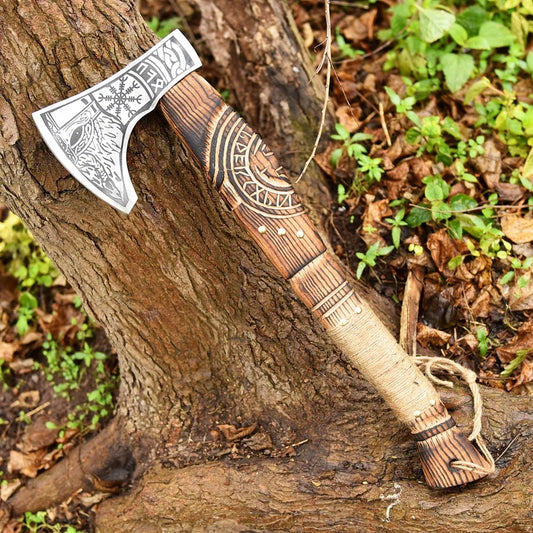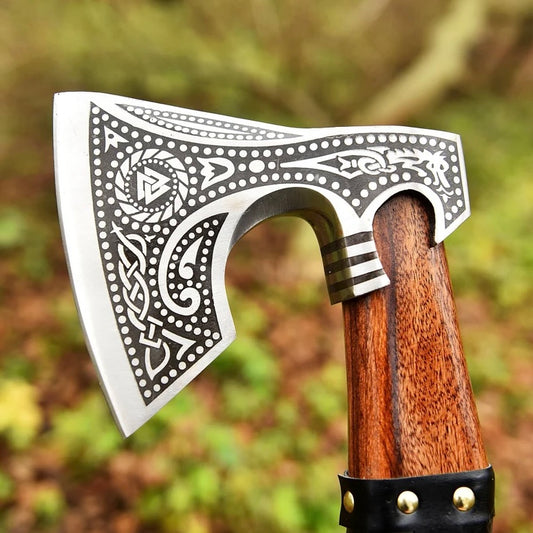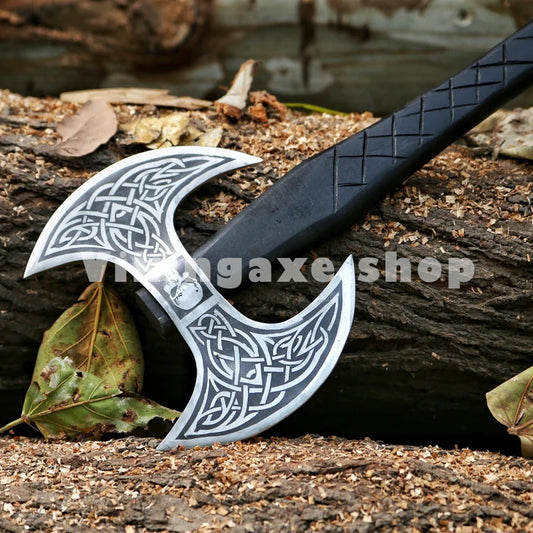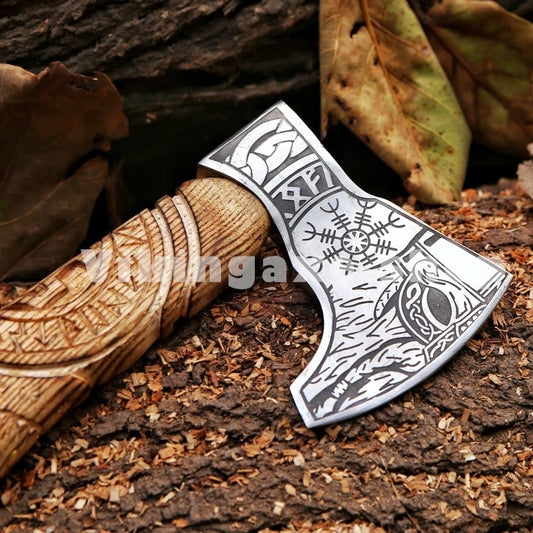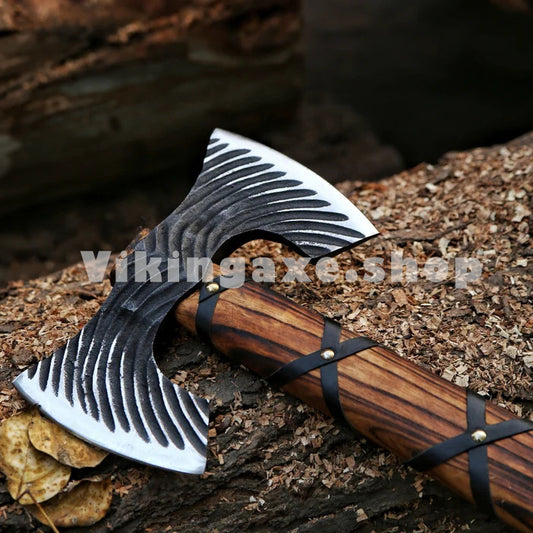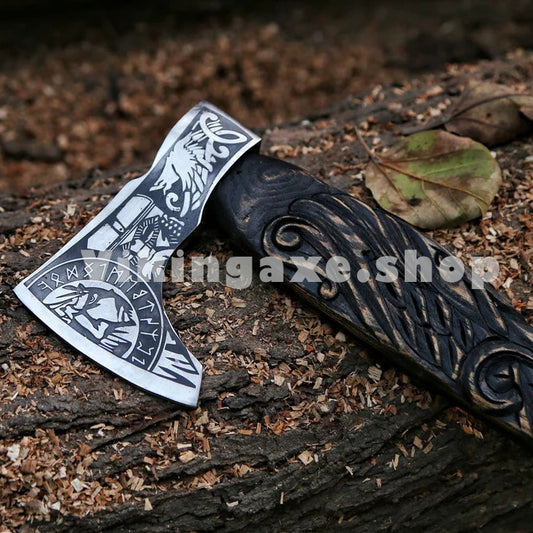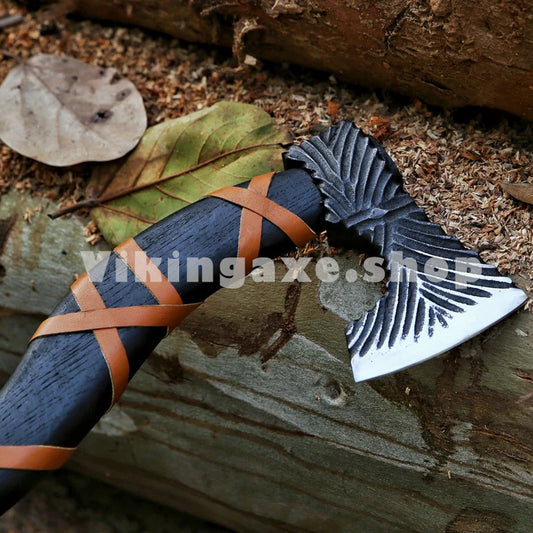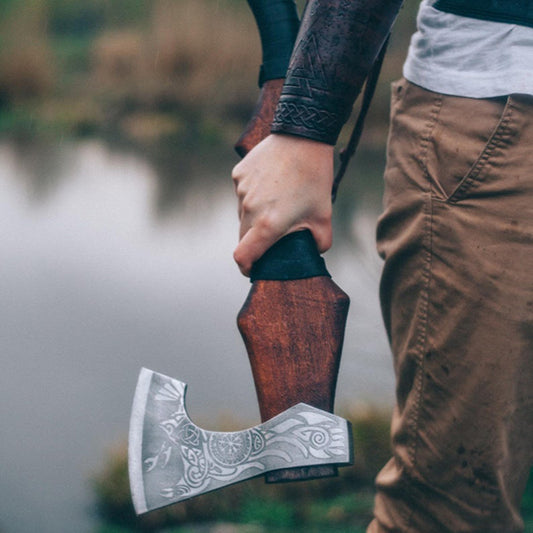
Viking Axes, Weapon With a Strong And Surprising Historical Background
Vikings are often portrayed holding axes large or small, looking scary and wild in their hands. Axes were indeed an integral part of Viking life. Not just like weapons, but as tools, they can do almost anything, in their daily lives. The axe was something all the Vikings needed to have and to know how to use it in their wooded, snowy lands. As a result, axes became widely used weapons during conflicts. Axes as weapons of war began as mere tools available on the Viking invasion. Another reason why axes have become such a popular weapon is because of their speed and compact size - large Viking axes are an exaggeration of the law in the Viking arsenal.
What are the Viking Axes?
Viking Axe is a handy tool with a variety of uses both on the battlefield and in home. At that time, swords were a luxury and only rich men could afford them. The axe, on the other hand, was virtually universal.
Over time the design and structure of the axes changed. Scandinavian people were well acquainted with the art of making axes. Originally, the head was made of stone but was gradually replaced by metal and steel.
There are several different types of axes used by heroes during the Viking era. Viking axes were usually light enough for a warrior to catch easily and throw an axe. The edge of the axe was sharpened to make it extremely sharp. There were also types of axes that were intended to fight close as they had a deadline. The most common of these are the Dane axe and the bearded axe.
The size of the Viking axes varied from one to five feet in length. The size and stiffness of the blade also varied. Dane axes often had the profile of a small blade with a large, curved cut edge that made them ideal for cutting leather weapons and injuring serious wounds. On the other hand, bearded axes were thicker and heavier, which enabled them to make better use of heavy duty such as chopping wood and splitting, but also helping them to deliver powerful blows to the enemy.
A Brief history of Viking Axes
The Stone Age is a period in human history that marks the arrival of tool production. The name comes from the fact that many cutting tools of the period are made of stone. Stone Age can be divided into:
The Early Stone Age, in which people made a living from hunting and fishing, covering a period from the earliest production of stone tools 2.5 million years ago to the end of the last Ice Age about 10,000-11,000 years ago - and
Late Stone Age, covering the period when farming became a way of life. The "Copper Age" is sometimes referred to as the period of transition from the Stone Age to the Bronze Age. The Axe is one of the oldest tools used by people. Old axes are known as hand axes.
The hand axe was a pear-shaped stone tool that had been cut to size. A hand axe was probably used for a variety of purposes, from slaughtering animals to digging for root crops. Gradually, the design was developed to fit knives, scrapers and arrow heads, among other things.
When, later, the axe was provided with a wooden handle, several types of axes were developed, which could be divided into two main groups: Hollow axes and hollow axes.
Revolution of the Viking Axes
About the 10th century, the Vikings 'axe became the most popular of all the Scandinavian landscapes where the Vikings' influence was very strong at the time and was one of the most widely used weapons of ancient Norse warriors. Medieval Norsemen used two common types of axes: the long axe and the hand axe.
The first-century Viking axes had sharp edges of 3 to 6 inches long, and later in the Viking period, the axes used became very large. Some broad axes, for example, had horizontal edges of 12 to 30 inches [9 to 18 cm]!
During the war, most Vikings could not afford to buy weapons such as swords (metal was expensive), so they carried an axe used to divide or chop wood to make their weapons in battle. It was a poor man's weapon, as all the Viking men had an axe in their house to carry out important tasks such as felling trees, chopping wood, and building, but that also meant that the Vikings were comfortable and able to use them.
Although the axe was not a good weapon, it was deadly. Talented Warriors were able to tear down the shields of their enemies like paper and could easily slip into a nearby battlefield. Eventually, however, the Vikings became rich and chose weapons that could be better controlled.
The Earliest Viking Axe
The Danish Axe is one of the earliest types of war axes used during the Viking Age and the early Middle Ages. Danish axes are also known as Dane axes, long English axes, and axes. This type of axe has a wide and narrow blade that includes a pointed horn on both toes and a bit of heel. This gives it a great cutting edge.
The Danish axe blade is usually 8-12 inches long and the hook has a small profile, which makes it ideal for making deep cuts - using strong leather tools.
The Most Common Viking Axe
One of the most common types of axes used during the Vikings was the bearded axe, also known as skeggox in the Old Norse. The lower part of the axe bit is known as the beard, which is so named because it extends beyond the axis below the axe head. The beard gave the axe a large cutting edge while keeping the axe weight low enough for it to fight. The beard also allowed the Viking warriors to pull and pull weapons from the enemy's hands or tear down the shield, allowing the axe-wielding companion or friend to strike down an unprotected enemy. Bearded axes are still used today in the woodworking industry, as they allow the user to grip the top and cut well with the axe.
What does the Viking axes signify?
The most famous and well-known Viking weapon is the axe. It was a famous Viking symbol representing weapons symbolizing strength, endurance and courage.
Along with their ships, weapons are also famous for their association with the Vikings. Most importantly in the invasion and defense, it was an integral part of the daily life of the Scandinavian people. We know many kinds of weapons, which show how war was fought 1000 years ago. Archaeologists have found them in cemeteries, lakes, near harbors, and battlefields from the Viking period. Each find is a small piece in a large jigsaw puzzle of Viking warfare.
During the Viking era a number of different types of weapons were used: swords, axes, bows and arrows, spears and spears. The Vikings also used a variety of weapons to defend themselves in battle: shields, helmets and chain mail. The weapons the Vikings had depended on their economic power. Although swords were expensive weapons of choice, axes and axes were affordable to the warriors of the great crowd. However, there are differences in the preservation of different types of weapons and equipment. For example, large numbers of swords and axes are still extinct today, while the acquisition of protective helmets and chains is extremely rare.
While in Viking style you can find a variety of Viking accessories, it is important to know their meaning, as some of the jewelry they wore had a special and unique purpose, bringing strength, power, inspiration, and glory to their lives. Symbols played a vital role in Norse culture. In those days people believed that some of the symbols were used to bring strength and faith, while others were used to summon their gods to protect them or even to instill fear in their enemies.
Why are Axes so closely correlated with Vikings?
The major reasons why the Vikings were so closely correlated with axes were that these objects were functional, perhaps most importantly, affordable.
During the Middle Ages, certain building materials were rare or very expensive. The same was true of metals such as iron and steel, from which the commercial ends of swords and axes were made.
Although a powerful double-edged sword is considered a child of the Viking military poster, the fact is that very few Viking heroes had it. During the Viking era, swords were very expensive to make, so only the rich and powerful fought them.
Swords were so valuable that they were passed down from generation to generation or were buried with the nobles as a burial place.In contrast, every free Viking man has an axe, whether a woodcutter doubled as a weapon during an attack or a special weapon designed specifically for combat situations.
The rivalry between the Vikings and their war axes intensified as news of their brutal exploits and military prowess spread throughout Northern Europe. Like many weapons of war, the axe was sharpened and polished as time went on to improve its mortality and performance on the battlefield.
Contrary to popular belief, the Viking war axe was not a heavy, shriveled object that needed to be facilitated by Thor.Viking warriors preferred to lighten their axes (most would weigh between 2 and 5 pounds) to speed up.
Axes Played a Vital Role During the Viking Period
As a very affordable and effective tool, almost all Viking men (except slaves) had an axe. In addition to being a beneficial weapon of the Viking style, the axe fulfilled other objectives that were equally significant in the Viking way of life.
- Farming and Homework: Contrary to popular belief, many Norse people during the Viking Period did not take part in the invasion. Instead, they were ordinary farmers, laborers, hunters, and craftsmen, relying on their hands, the sweat of their brow, and the abundance of land for their sustenance.Logging Wood for building materials
- Shipbuilding: One of the achievements of the Viking Age was the completion of the long Viking architecture. Since many scholars are considered to be a marvel of naval engineering, this unique vessel enabled Norse warriors to navigate in shallow waters and strike unexpected weapons with unpredictable speed.
- Surprisingly, each Viking boat was built by hand and without the use of saws.
- Indigenous trees such as oak and pine were separated from the grain by axes and columns to form a series of fused planks to produce a signature linker design that gave Viking ships its unusual strength and flexibility.
Conclusion: Final thoughts
Viking axes are whether used to cut logs or to strike enemy forces, the axe was an important part of Norse growth during the Viking Age. The history of the Viking axes is remarkable. I hope this article has helped you to get an idea of those glorious times. The good news is that with modern technology and online shopping, you can find Viking axe replicas of high quality where over the years and decades ago it would have taken you a trip to speciality vendors or ordered from a metalworker to get your hands on such a thing. . In any case, the Vikings were an interesting, enthusiastic people who wanted to live, even with all their evil. Their tools - and weapons - were simple, but effective. And they changed the course of Western history with their travels, invasions, and invasions. Not bad for a few farmers and fishermen from the cold northern Europe!
